 W
WAetobatus is a genus of eagle rays native to the Atlantic, Pacific and Indian Oceans. It was formerly placed in Myliobatidae, but is now placed in its own family based on salient differences from myliobatids, especially the pectoral fins joining the head at the level of the eyes.
 W
WAetobatus laticeps, the Pacific white-spotted eagle ray, is a species of cartilaginous fish in the eagle ray family Myliobatidae. It is found in the tropical East Pacific Ocean, ranging from Baja California to northern Peru, including the Galápagos. Until 2014, it was included in the similar spotted eagle ray, but the two differ in genetics. Following the split, A. narinari is restricted to the Atlantic, while the Indo-Pacific is inhabited by the closely related A. ocellatus.
 W
WAetobatus narutobiei, the Naru eagle ray, is a species of cartilaginous fish of the eagle ray family, Myliobatidae. It is found in the northwest Pacific off south Japan, South Korea, China, Hong Kong and Vietnam. It occurs from shallow, coastal flats to a depth of 59 m (194 ft), but always in water warmer than 15 °C (59 °F).
 W
WThe ocellated eagle ray is a species of cartilaginous fish in the eagle ray family Myliobatidae. It is found in the tropical Indo-West Pacific region. In the past it was included in the spotted eagle ray, a species restricted to the Atlantic after the split.
 W
WAetomylaeus is a genus of eagle ray in the family Myliobatidae.
 W
WAntiquaobatis is an extinct genus of ray from the Early Jurassic of Europe, containing the single species A. grimmenensis. It is the oldest known described member of the Rajiformes, and is based on a single tooth from Pliensbachian of Northern Germany. It was recovered fom the Grimmen Clay Pit, on Spinatum strata that belongs in the region to the Komorowo Formation. The holotype is a single antero-lateral tooth, very small and slightly asymmetrical, measuring 0.25 mm in maximum height and 0.26 mm in maximum width, that has an overall morphology, that suggests a consistent referral to Batomorphii, encompassing all skates and rays. The tooth has an overall rather gracile crown morphology, different from any other know jurassic batomorphs, indicating closest affinities to the monotypic genus Engaibatis schultzei from the Kimmeridgian-Tithonian of Tanzania.
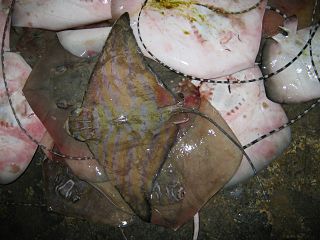 W
WThe banded eagle ray is a species of fish in the family Myliobatidae. It is found in Australia, Bangladesh, Brunei, Cambodia, China, India, Indonesia, Japan, North Korea, South Korea, Malaysia, Myanmar, Pakistan, Papua New Guinea, the Philippines, Singapore, Sri Lanka, Taiwan, Thailand, Vietnam, possibly Maldives, and possibly Mozambique. Its natural habitats are open seas, shallow seas, and coral reefs. It is threatened by habitat loss.
 W
WThe bullnose ray is an eagle ray, which is widely distributed in the western Atlantic. It is found at depth above 10 m (33 ft) in coastal waters from Cape Cod down to Argentina, but is absent from parts of the western central Atlantic. It reaches a maximum size of 106 cm (42 in) in disc width and gives birth to six young per litter. It is often confused with the southern eagle ray.
 W
WCallorhinchus callorynchus, the elephantfish or cockfish, is a species of fish in the family Callorhinchidae found in Peru, Chile, Argentina, Uruguay, and southern Brazil. Its natural habitat is open seas.
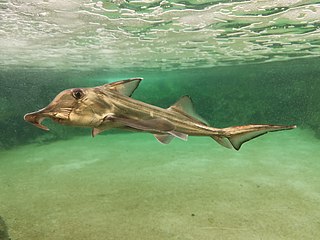 W
WThe Cape elephantfish, josef, or St Joseph shark is a species of fish in the family Callorhinchidae.
 W
WThe Chilean eagle ray is a species of fish in the family Myliobatidae. Found off the coasts of Chile and Peru, its natural habitat is open sea.
 W
WChimaera is the type genus of the cartilaginous fish family Chimaeridae.
 W
WThe gulf chimaera is a species of cartilaginous fish in the family Chimaeridae found near Mexico, the United States, and possibly Suriname. Its natural habitat is open seas.
 W
WThe purple chimaera or purple ghostshark is a species of fish in the family Chimaeridae found off Japan and Hawaii. Its natural habitat is open seas.
 W
WThe Cuban chimaera is a species of fish in the family Chimaeridae. It is found in Colombia, Cuba, and Puerto Rico. Its natural habitat is open seas. It is threatened by habitat loss.
 W
WDasyatis ushiei, the cow stingray or Ushi stingray, is a species of stingray known from a single specimen. Based on the single specimen, its range includes at least Mikawa Bay, Aichi Prefecture, middle Japan. Due to the limited knowledge of its biology and extent of capture in fisheries, this species is assessed as Data Deficient.
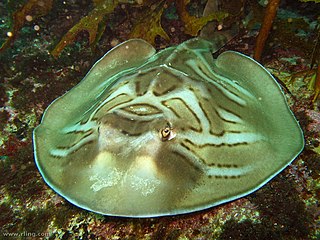 W
WTrygonorrhina, also known as the fiddler rays or banjo rays, is a genus of guitarfish, family Rhinobatidae. The two species are found along the eastern and southern coasts of Australia. They are benthic in nature, favoring shallow, sandy bays, rocky reefs, and seagrass beds. The eastern fiddler is found to a depth of 120 m and the southern fiddler to a depth of 180 m.
 W
WGill slits are individual openings to gills, i.e., multiple gill arches, which lack a single outer cover. Such gills are characteristic of cartilaginous fish such as sharks, and rays, as well as deep-branching vertebrates such as lampreys. In contrast, bony fishes have a single outer bony gill covering called an operculum.
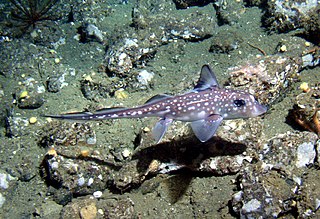 W
WHydrolagus is a genus of fish in the family Chimaeridae found in the Atlantic, Indian and Pacific Oceans.
 W
WHydrolagus mitsukurii is a species of fish in the family Chimaeridae found in China, Japan, South Korea, the Philippines, Taiwan, and possibly Indonesia. Its natural habitat is open seas. It is one of several species commonly called "spookfish".
 W
WHydrolagus pallidus is a marine species of fish in the family Chimaeridae found in the Northeast Atlantic Ocean, specifically near Iceland and the Canary Islands. It is commonly known as the pale chimaera or pale ghost shark, although it is not a true shark. Its natural habitat is deepwater seas and near the mid-Atlantic ridge. H. pallidus is found at a depth range of 800 - 3650 m. This species faces a potential threat as bycatch of deepwater trawl fisheries especially as deepwater fisheries operate at greater depths. It has been recognized as distinct from Hydrolagus affinis, its closest relative, since 1990.
 W
WJordan's chimaera is a species of fish in the family Chimaeridae found near Japan, Madagascar, and Mozambique. Its natural habitat is open seas.
 W
WTorpedo panthera also known as the leopard torpedo is a species of fish in the family Torpedinidae. It is found in Djibouti, Egypt, Eritrea, India, Iran, Oman, Pakistan, Saudi Arabia, Somalia, Sudan, and Yemen. Its natural habitat is open seas.
 W
WMobula eregoodootenkee is a species of ray in the family Mobulidae. It is endemic to the Indian Ocean and central-west Pacific Ocean. It ranges from South Africa in the west to the Philippines in the east, north to Vietnam, and south to the northern coast of Australia.
 W
WThe Mobulidae are a family of rays consisting mostly of large species living in the open ocean rather than on the sea bottom.
 W
WThe mottled eagle ray is a species of fish in the family Myliobatidae.
 W
WNarke is a genus of electric rays in the family Narkidae, found in the western Indo-Pacific and off southern Africa. They have nearly circular pectoral fin discs and short, thick tails with large caudal fins, and can be identified by their single dorsal fin. There are three described species, as well as a fourth undescribed dwarf species from Taiwan.
 W
WThe numbray or spottail sleeper ray is a species of electric ray in the family Narkidae. It may be found in shallow muddy estuaries or offshore depths. It is a weak swimmer that lies on the bottom, commonly buried. It eats small marine invertebrates and fish. It pounces on its prey and wraps its body around its prey, killing or stunning it with electrical shocks. It has been observed that Numbrays are not as common as other types of rays in the area around the Indian Ocean. This can be attributed to the relatively large doubling time for a population, reaching up to 18 years.
 W
WThe operculum papillare is the iris found in the eyes of elasmobranchs. It can undergo pupillary light reflex to such an extent that the eye is essentially shut off. It is sometimes called the golden iris because of the shine it sometimes causes.
 W
WThe ornate eagle ray or reticulate eagle ray is a species of large stingray of the family Myliobatidae.
 W
WThe Peruvian eagle ray is a species of fish in the family Myliobatidae. It is found in the Pacific Ocean off Chile and Peru. It can be differentiated from the similar Chilean eagle ray by color and rostral fin form. The ray has not been extensively studied, and is ranked as Data Deficient by the IUCN. It has been recorded only in the open ocean, but is considered likely to be a benthic feeder. It is thought by scientists to be similar to other myliobatids in terms of biology, habits, and threats.
 W
WPotamotrygon orbignyi, or the smooth back river stingray, is a species of river stingray in the family Potamotrygonidae. It is found in the Amazon and Orinoco River basins in South America.
 W
WPotamotrygon tigrina, also known as the tiger river stingray, is a species of freshwater ray in the family Potamotrygonidae. This endangered species is endemic to black- and whitewater rivers in the upper Amazon basin in northeastern Peru. It is sometimes kept in aquariums and has been bred in captivity, but it is generally a sensitive species.
 W
WPristiophorus is a genus of sawsharks found in the Pacific, Atlantic and Indian oceans. Members of this genus differ from the Sixgill Sawshark (Pliotrema warreni) in having five gill slits. Their rostral sawteeth lack prominent transverse ridges on the basal ledges, and the large teeth are not posteriorly serrated.
 W
WThe Chilean devil ray, also known as the box ray, greater Guinean mobula, sicklefin devil ray or the spiny mobula, is a species of ray in the family Mobulidae. It is found worldwide in tropical, subtropical and warm temperate oceans, and mainly occurs offshore, only occasionally appearing near the coast. These fish have been discovered to feed at depths up to 1,848 metres (6,063 ft) during deep dives, and are among the deepest-diving ocean animals. There are two distinct deep dive patterns; the first, which is usually only performed once every 24 hours, is diving to the maximum depth and resurfacing after 60 to 90 minutes; the second, which is less frequent, is dives up to 1,000 meters for a maximum of 11 hours. The latter pattern may be associated with traveling rather than feeding. It can reach a disc width of up to 3.7 m (12 ft).
 W
WThe painted electric ray or variegated electric ray is a poorly known species of numbfish, family Narcinidae, native to the western Atlantic Ocean from southeastern Venezuela to the mouth of the Amazon River in Brazil. It is common on soft substrates at a depth of 2–120 meters.
 W
WRhinochimaera is a genus of cartilaginous fish in the family Rhinochimaeridae, with these species:Rhinochimaera africana Compagno, Stehmann & Ebert, 1990 Rhinochimaera atlantica Holt & Byrne, 1909 Rhinochimaera pacifica Mitsukuri, 1895
 W
WThe Rhinochimaeridae, commonly known as long-nosed chimaeras, are a family of cartilaginous fish. They are similar in form and habits to other chimaeras, but have an exceptionally long conical or paddle-shaped snout. The snout has numerous sensory nerve endings, and is used to find food such as small fish. The first dorsal fin includes a mildly venomous spine, used in defense.
 W
WOgilby's ghostshark, also known as the whitefish, is a species of chimaera endemic to the waters of Australia. It lives near the ocean floor on the continental shelf and continental slope 120–350 m (390–1,150 ft) deep. It reaches a maximum size of 85.0 cm (33.5 in). Reproduction is oviparous and eggs are encased in horny shells. It reaches maturity between 64–70 cm (25–28 in) in length. It is listed as a Vulnerable species by the International Union for the Conservation of Nature (IUCN) due to steep declines in population in areas affected by trawling.
 W
WThe silver chimaera is a species of fish in the family Chimaeridae found near Australia, China, Japan, North Korea, South Korea, New Caledonia, the Philippines, Taiwan, and Vietnam. Its natural habitat is open seas.
 W
WUrobatis maculatus, also known as the spotted round ray or Cortez round stingray, is a species of round ray endemic to Mexico. Its natural habitats are shallow seas, subtidal aquatic beds, coral reefs, estuarine waters, intertidal marshes, and coastal saline lagoons. This species reaches a length of 42 centimetres (17 in) TL. This species is placed in the genus Urobatis and the family Urotrygonidae.
 W
WTortonese's stingray is a species of stingray in the family Dasyatidae, endemic to the Mediterranean Sea. It may be the same species as the common stingray.
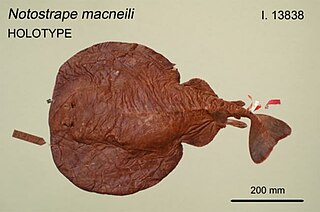 W
WTetronarce macneilli, commonly known as the Shorttail torpedo, is a species of large electric ray. The taxonomy of the species has been long debated and has been suggested that it is synonymous with Torpedo fairchildi.
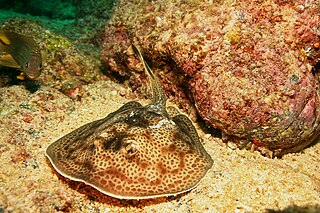 W
WUrobatis is a genus of the family Urotrygonidae. These rays live in Costa Rica, Mexico, the Bahamas, El Salvador, Honduras, Guatemala, Nicaragua, Colombia, Venezuela, Panama, Trinidad and Tobago, Barbados, Grenada, Saint Vincent and the Grenadines, Saint Lucia, Martinique, Dominica, Guadeloupe, Montserrat, Antigua and Barbuda, Belize, Puerto Rico, Saint Kitts and Nevis, Anguilla, Dominican Republic, Haiti, Jamaica, Cuba, Cayman Islands, Virgin Islands, Turks and Caicos Islands, French Guiana, Guyana, Suriname, Chile, Peru, Ecuador and the United States.
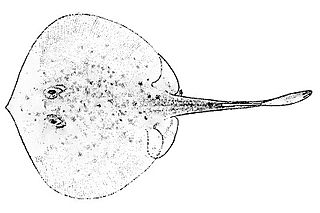 W
WUrotrygon is a genus of American round stingrays. The last two species were described in 1988.
 W
WUrotrygonidae is a family of rays in the order Myliobatiformes, commonly referred to as the American round stingrays or round rays. They are native to the tropical and warm temperate marine waters of the Americas. The two genera in this family were formerly placed within the family Urolophidae, whose species are now restricted to the Indo-Pacific. They have a round pectoral fin disk, a slender tail with a caudal fin, no dorsal fins, and a venomous tail spine.
 W
WThe whiptail stingrays are a family, the Dasyatidae, of rays in the order Myliobatiformes. They are found worldwide in tropical to temperate marine waters, and a number of species have also penetrated into fresh water in Africa, Asia, and Australia. Members of this family have flattened pectoral fin discs that range from oval to diamond-like in shape. Their common name comes from their whip-like tails, which are much longer than the disc and lack dorsal and caudal fins. All whiptail stingrays, except the porcupine ray, have one or more venomous stings near the base of the tail, which is used in defense. They range in size from 0.18 to 2.0 m or more across.